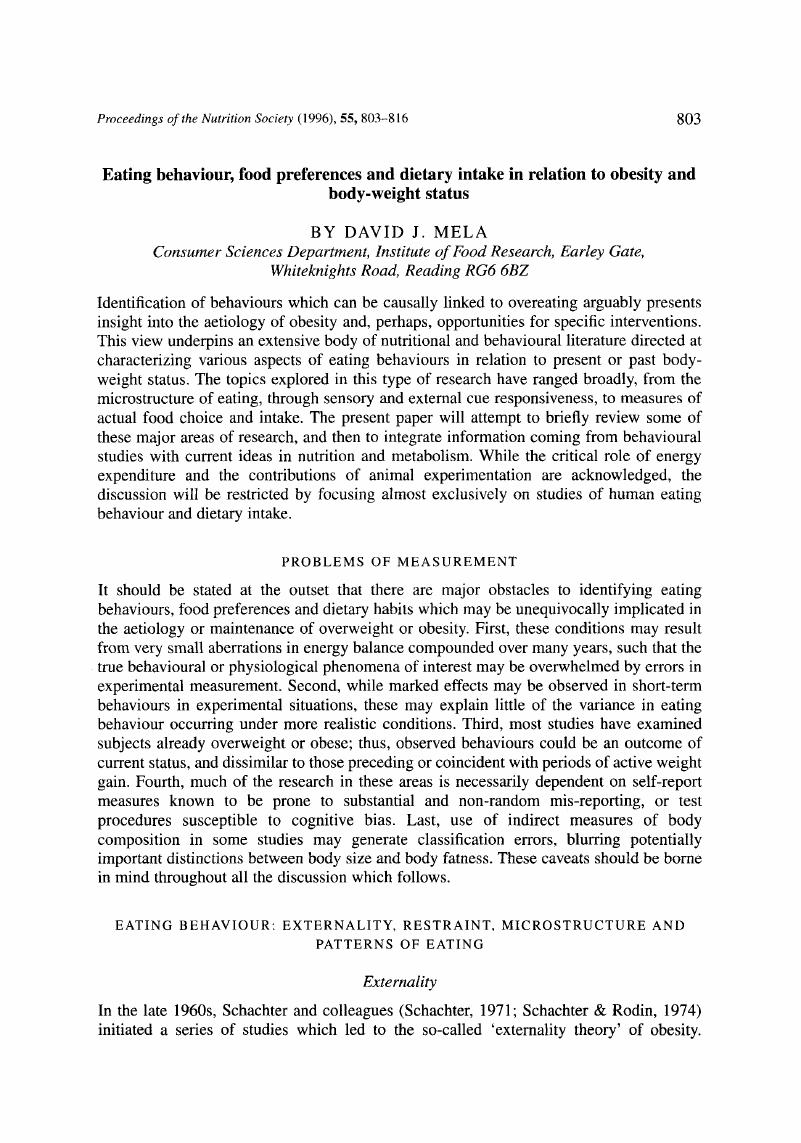Crossref Citations
This article has been cited by the following publications. This list is generated based on data provided by Crossref.
Cox, David N.
Van Galen, Marjolein
Hedderley, Duncan
Perry, Lynne
Moore, Peter B.
and
Mela, David J.
1998.
Sensory and Hedonic Judgments of Common Foods by Lean Consumers and Consumers with Obesity.
Obesity Research,
Vol. 6,
Issue. 6,
p.
438.
Prentice, AM
1998.
Manipulation of dietary fat and energy density and subsequent effects on substrate flux and food intake.
The American Journal of Clinical Nutrition,
Vol. 67,
Issue. 3,
p.
535S.
SMITH, BRENDA K.
KELLY, LISA A.
PIÑA, RICARDO
YORK, DAVID A.
and
BRAY, GEORGE A.
1998.
Preferential Fat Intake Increases Adiposity but not Body Weight in Sprague-Dawley Rats.
Appetite,
Vol. 31,
Issue. 2,
p.
127.
Mangweth, Barbara
Hudson, J. I.
Pope, H. G.
Oberleit, S.
De Col, C.
Kinzl, J.
and
Biebl, W.
1999.
Knowledge of calories and its effect on eating behavior in overweight, normal weight, and underweight individuals.
Eating and Weight Disorders - Studies on Anorexia, Bulimia and Obesity,
Vol. 4,
Issue. 4,
p.
165.
Smith, Brenda K.
Andrews, P. Kyle
York, David A.
and
West, David B.
1999.
Divergence in proportional fat intake in AKR/J and SWR/J mice endures across diet paradigms.
American Journal of Physiology-Regulatory, Integrative and Comparative Physiology,
Vol. 277,
Issue. 3,
p.
R776.
Smith, Brenda K.
Andrews, P. Kyle
and
West, David B.
2000.
Macronutrient diet selection in thirteen mouse strains.
American Journal of Physiology-Regulatory, Integrative and Comparative Physiology,
Vol. 278,
Issue. 4,
p.
R797.
Schenker, Sarah
2000.
The nutritional and physiological properties of chocolate.
Nutrition Bulletin,
Vol. 25,
Issue. 4,
p.
303.
Steptoe, Andrew
Doherty, Sheelagh
Kerry, Sally
Rink, Elizabeth
and
Hilton, Sean
2000.
Sociodemographic and psychological predictors of changes in dietary fat consumption in adults with high blood cholesterol following counseling in primary care..
Health Psychology,
Vol. 19,
Issue. 5,
p.
411.
NYGREN, I.T.
GUSTAFSSON, I.‐B.
HAGLUND, Å
JOHANSSON, L.
and
NOBLE, A.C.
2001.
FLAVOR CHANGES PRODUCED BY WINE AND FOOD INTERACTIONS: CHARDONNAY WINE AND HOLLANDAISE SAUCE.
Journal of Sensory Studies,
Vol. 16,
Issue. 5,
p.
461.
Nasser, J.
2001.
Taste, food intake and obesity.
Obesity Reviews,
Vol. 2,
Issue. 4,
p.
213.
Camerini, Giovanni
Adami, Gian Franco
Marinari, Giuseppe M.
Campostano, Adelia
Ravera, Giambattista
and
Scopinaro, Nicola
2001.
Failure of Preoperative Resting Energy Expenditure in Predicting Weight Loss after Gastroplasty.
Obesity Research,
Vol. 9,
Issue. 9,
p.
589.
Ulijaszek, Stanley J.
2002.
Human eating behaviour in an evolutionary ecological context.
Proceedings of the Nutrition Society,
Vol. 61,
Issue. 4,
p.
517.
Provencher, Véronique
Drapeau, Vicky
Tremblay, Angelo
Després, Jean‐Pierre
and
Lemieux, Simone
2003.
Eating Behaviors and Indexes of Body Composition in Men and Women from the Québec Family Study.
Obesity Research,
Vol. 11,
Issue. 6,
p.
783.
2004.
Effect of Academic Examination Stress on Taste Perception and Nutrient Intake in University Students.
Journal of the Korean Society of Food Science and Nutrition,
Vol. 33,
Issue. 2,
p.
349.
Ulijaszek, Stanley J.
and
Lofink, Hayley
2006.
Obesity in Biocultural Perspective.
Annual Review of Anthropology,
Vol. 35,
Issue. 1,
p.
337.
la Fleur, S E
Vanderschuren, L J M J
Luijendijk, M C
Kloeze, B M
Tiesjema, B
and
Adan, R A H
2007.
A reciprocal interaction between food-motivated behavior and diet-induced obesity.
International Journal of Obesity,
Vol. 31,
Issue. 8,
p.
1286.
Benelam, B.
2009.
Satiation, satiety and their effects on eating behaviour.
Nutrition Bulletin,
Vol. 34,
Issue. 2,
p.
126.
Ritz, Patrick
Bertrand, Monelle
and
Hanaire, Hélène
2011.
Handbook of Behavior, Food and Nutrition.
p.
2713.
Ulijaszek, Stanley J.
2011.
Global Perspectives on Childhood Obesity.
p.
463.
Keeley, R.J.
Zelinski, E.L.
Fehr, L.
and
McDonald, R.J.
2014.
The effect of exercise on carbohydrate preference in female rats.
Brain Research Bulletin,
Vol. 101,
Issue. ,
p.
45.



